In a demonstration trailer designed to approximate the interior of the E-7A Wedgetail airborne early warning and control (AEW&C) aircraft, Boeing officials offered The War Zone and a handful of other reporters fascinating details about the E-7’s unique capabilities and painted a picture of why Air Force commanders can’t wait to get their hands on this jet.
But that’s a few years off. Earlier this month, the Air Force signed a contract valued up to $1.2 billion to begin procuring Wedgetails – first designed for the Australian Air Force – to begin replacing the rapidly aging fleet of E-3 Sentry Airborne Warning And Control System, or AWACS jets. The first model is not expected to be fielded until Fiscal Year 2027.
So in the interim, the U.S. Air Force is relying on the E-3 to provide that critical function of quarterbacking the air war.
The MESA Advantage
But the E-3 “is almost 60 years old,” Boeing’s Rod Meranda, senior manager of Business Development, Mobility, Surveillance and Bombers stated in the E-7 trailer during the recent Air and Space Forces Association Air Warfare Symposium outside of Denver. “It’s not just the airplane…It’s old engines – TF33 engines that we don’t produce anymore. The 707 airframe supply chain, all of those parts and stuff like that. There’s only the KC-135 [Stratotanker aerial refueling jets]. No commercial [airlines or] anybody’s flying those airplanes. So that’s the airframe from a capability perspective.”

Meranda continued, “Just remember [the E-7 has] an AESA [active electronically scanned array] sensor.”
In contrast with the E-7’s slab-sided Multi-Role Electronically Scanned Array (MESA), said Meranda, the E-3s use “an old APY” mechanically scanned array sensor that rotates atop the jet in its trademark disc enclosure.
“Let’s turn around and take a look at the scopes,” said Carson Elmore, senior Business Development representative (International E-7 Program) for Boeing, in an effort to show, not just tell, the difference between the two radars. “Because you’re hitting on a very key point. You have a mechanically scanned array that’s on AWACS. Once every 10 seconds, it’s looking where you want it to look – at a tactical asset – and that tactical asset can be moving at more than 400 knots. So you turn away for 9.9 seconds and come back to look. Where is it, moving at 400 knots? The volume of airspace where it might be is very large. What you can do with an AESA is you manage your energy, and you manage where you look.”
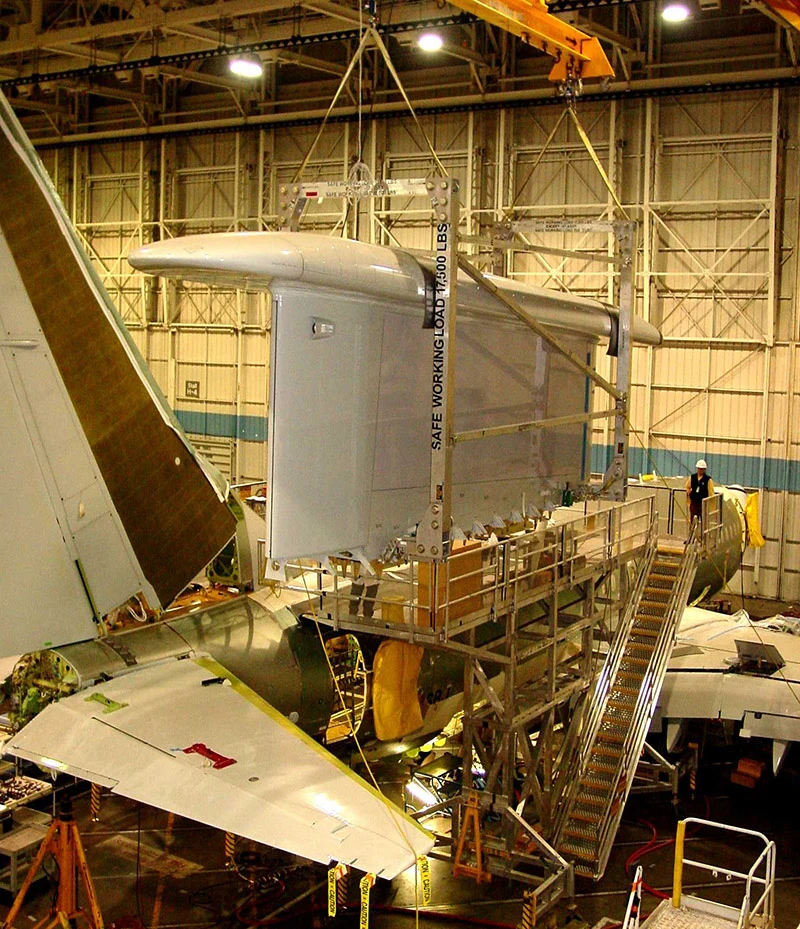
Elmore pointed to simulated radar scope images on a bank of five workstations along a wall of the trailer.
“This is just a representation, it doesn’t sweep like this, you know, but we put this on so people understand it, they can see what it’s doing. Let me orient you to it. The green is the IFF [identification friend-or-foe]. That’s integrated with the yellow, which is radar [aerial radar], which is integrated with the blue, which is maritime [radar]. So it’s looking across all of those three things all the time. And here’s the special thing. I can tell it I want a higher quality bit of data on this target down this bearing. And now I can change how often I revisit on that track. And that’s what those purple lines are showing you.”
“Essentially it comes down to the ability to stare at something. So you’re not doing once every 10 seconds, and he’s doing 400 knots. You’re doing [things] very rapidly – I’m looking constantly. So the volume of airspace where that aircraft or that target could possibly be becomes very finite. And your quality of service becomes great as you provide that out to other assets in the joint force.”

When asked if the E-7’s radar provided a constant scan or refreshes, Elmore offered that “it has a Hertz revisit – we’re not going to talk about that with you. But it has the ability to do rapid re-looks down wherever you want to look. You have a radar timeline, because your T/R [transmit/receive] modules – now we’re getting the physics and math and all the rest of it, and you have a certain amount of time you can manage that energy and say ‘do something for me.’ And part of that is ‘look at that target quickly for me and often… whatever that pace may be, and then occasionally take a look back around me to make sure somebody’s sneaking up on me. Unless I say ‘don’t waste any energy out behind me. Put all my radar timeline going that direction.’”
“So the operator on the AWACS [E-3 Sentry], I just get whatever I get. Here [on the E-7], now that operator can sit there and go, ‘I want to look at this particular area and got more power and more constantly looking at certain areas.’’

The E-7s also have passive sensors, says Elmore, “just like our other AWACS fleets out there, it has the passive ability to listen for RF signals called Electronic Support Measures (ESM). That’s the gray lines you see coming out there (on the display). And where we can locate, geolocate, triangulate, pick up things on the ground, and locate them or look at the emissions that are coming off a moving target and help us characterize and identify that based on a classified library…”
Detection, and how far the E-7’s sensors can scan are “typically based on four things, and we won’t go into that,” said Elmore. ”But you need power. You need a band. And you need an array. And then that target has a radar cross-section. They control that target. Every target. As Rod said, we have these generators on the engines, two 90-volt generators [on each engine], so four. So you’ve got 360-kilovolt amps of power going across this AESA array that’s up top with 104 square feet looking at each side in the L band. And you are able to reach out and see radar cross-section assets at a very, very good range.”
“Well, that’s great. You can detect it. But so what? Well, if I’m looking at it rapidly, multiple detections turned into a track. Now it comes into that mission computing and tracks are what we deal on. I give a track to a fighter asset – I give a track to a naval asset so they can employ what they need to do to take the right response with that threat… or whatever that’s coming out there. That’s what we do. We’re up at altitude. And so we’re not shaded by the curvature of the earth – by 1.23 times the square root of the altitude. So 35,000 feet – that’s 230 miles before someone starts hiding from you, if they’re skimming on the earth.”
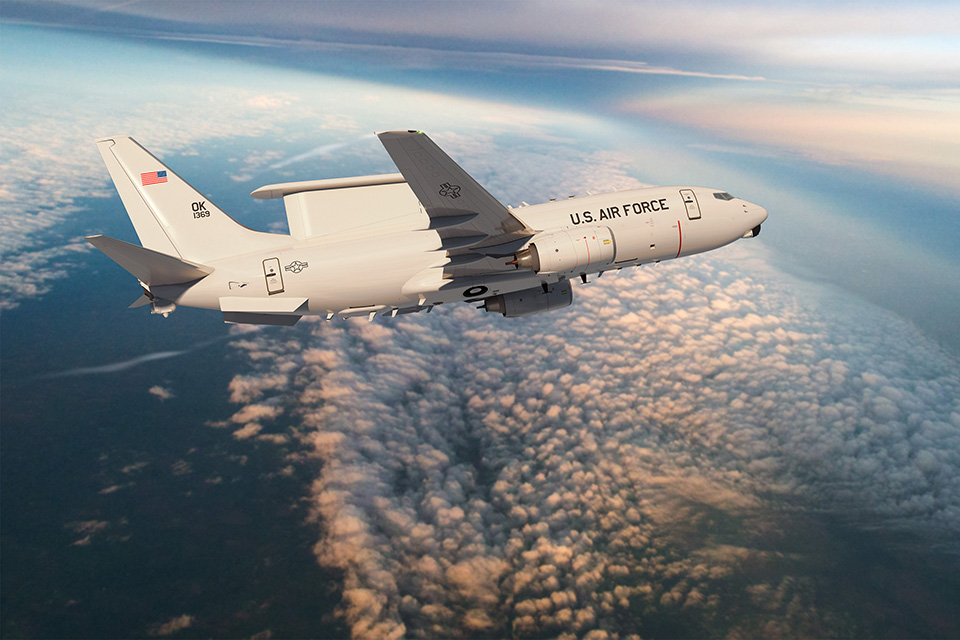
“So we were not sitting up on the front line, we’re back a little bit, but we can see well over to the other side, get that information, turn it into a track, characterize, identify, apply the rules of engagement, if that’s with us, and get it off to decision makers or people who may or may not shoot weapons.”
Meranda then talked about alternative platforms and their limitations.
“People say, ‘why can’t an unmanned platform [perform this mission]? Remember the size of the sensor array. Small-nose airplanes – fighters? Small nose, right? Small radar. You can only go look at certain things. Power. Can’t put this kind of power on unmanned. So how do you do this in space? Same thing…massive array gives you a lot of capability.”
A More Connected Platform
Meranda detailed how the aircraft is just as much a data fusion and broadcasting center as it is a sensor.
“So why do I need [the E-7]? Right? Because everybody always asks us, ‘What can it do? So what? What’s the difference between this and space? Why would I risk putting this kind of money [into building it]? Why do I need this? It’s gonna get shot down.’ And I’m gonna go, ‘what are we doing with that information? Right?’ That’s the next question. ‘So what?’ So talk about, ‘okay, why do I need these people? What are these people actually doing? How is this information getting out to the people that need it? The shooters. The bombers.’ That’s what this platform does. So it integrates all of this information that’s coming off of here and getting it off. It doesn’t stay on here. It’s getting to the shooters, the killers, the decision-makers. Whether it’s all the way back to an AOC [air operations center], through SATCOM, through space assets, through ground assets, whoever needs it, okay. So it has a lot of information and it disseminates that information.”
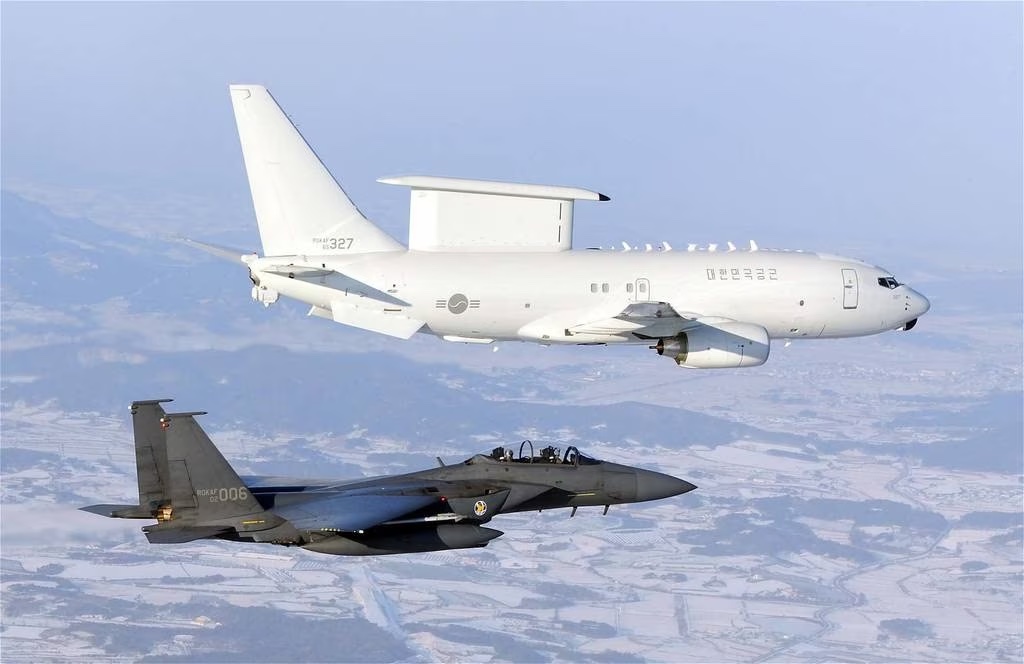
Defense News reporter Steve Losey asked Elmore what a particular switch on the console does.
“This is the intercom system,” Elmore responded. “So it’s got plenty of radios – 14 radios. The Air Force is putting in some new mandate-compliant radios into it. We have anywhere from VHF up to HF and SATCOM. We have a beyond-line-of-sight wideband SATCOM capability we’re bringing onto the airplane.”
There are frequent questions, said Elmore, about whether the operators get confused because “everyone’s touching the same radio.”
“The crews are trained,” he said. “They have TTPs [tactics, techniques and procedures]. They know how to share radios. They know how to operate the radios. They set it up and that’s how they communicate onboard the airplane with one another. That’s how they communicate off the airplane.”

When asked by The War Zone whether the E-7 is interoperable with the orbital missile warning and/missile tracking capabilities of the future National Defense Space Architecture, as well as other space-based early warning capabilities, existing or on the horizon that were recently touted as a possible replacement for the E-3, Elmore said: “we’re interoperable with the joint forces and assets that are out there. There’s information that’s being detected by overhead and turned into the standard configuration and shared that can come into our mission computing and we can use it and we can deal with it and disseminate it through the data link architecture.”
Smarter Not Larger
The AWACS is a much bigger airplane with a larger crew than the Wedgetail, said Elmore.
“You have operators who are looking at scopes and doing things. You have technicians, who are turning things on and off and fixing [things]. You used to have four people up in the flight deck to fly the airplane. We’re all ex-AWACS people. We got plenty of hours in the airplane – it’s a lot [of people]. Well, with today’s technology, and the capabilities using machine information – I’m not going to say AI without doing this [Elmore made air quotes]. We put in some tool sets and algorithms – you can start eliminating some people.”
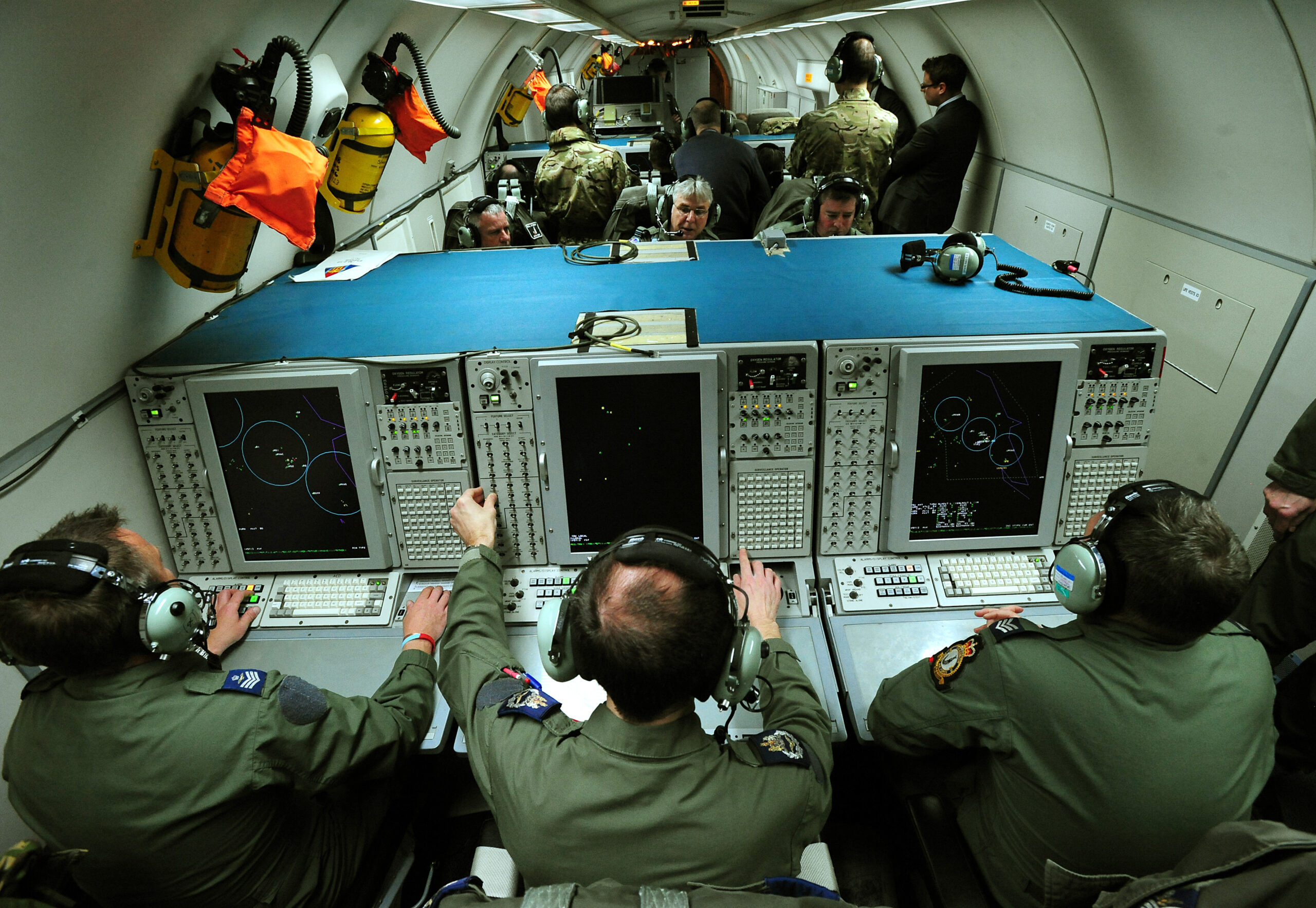
“So all of the tracking on AWACS? You had a whole set of people who worked on tracking and identifying, and you pay them to do it…We’ve eliminated them because the machine does it. We have these technicians who are turning it on and off. We’ve eliminated them because one person can turn it off. You know the complete health of your airplane before you even turn the engines on and leave your chalks. So we’ve come down to basically a 12-person aircraft… with two pilots up front. There’s a jump seat, if you’re flying long missions, or you want to bring an extra person.”

“If you come into the airplane, you’d see six seats – we have five here – but six down the port side and four down the starboard side for 10 mission operators, and their scopes are all agnostic to what you’re going to do. You turn it on, they get all the information the same. You can do whatever job you want to do, whether you’re directing airplanes, whether you’re making identifications on airplanes. Or you’re listening, and you’re taking in that RF energy and applying…whatever you’re trained to do and make classifications based off of that.”
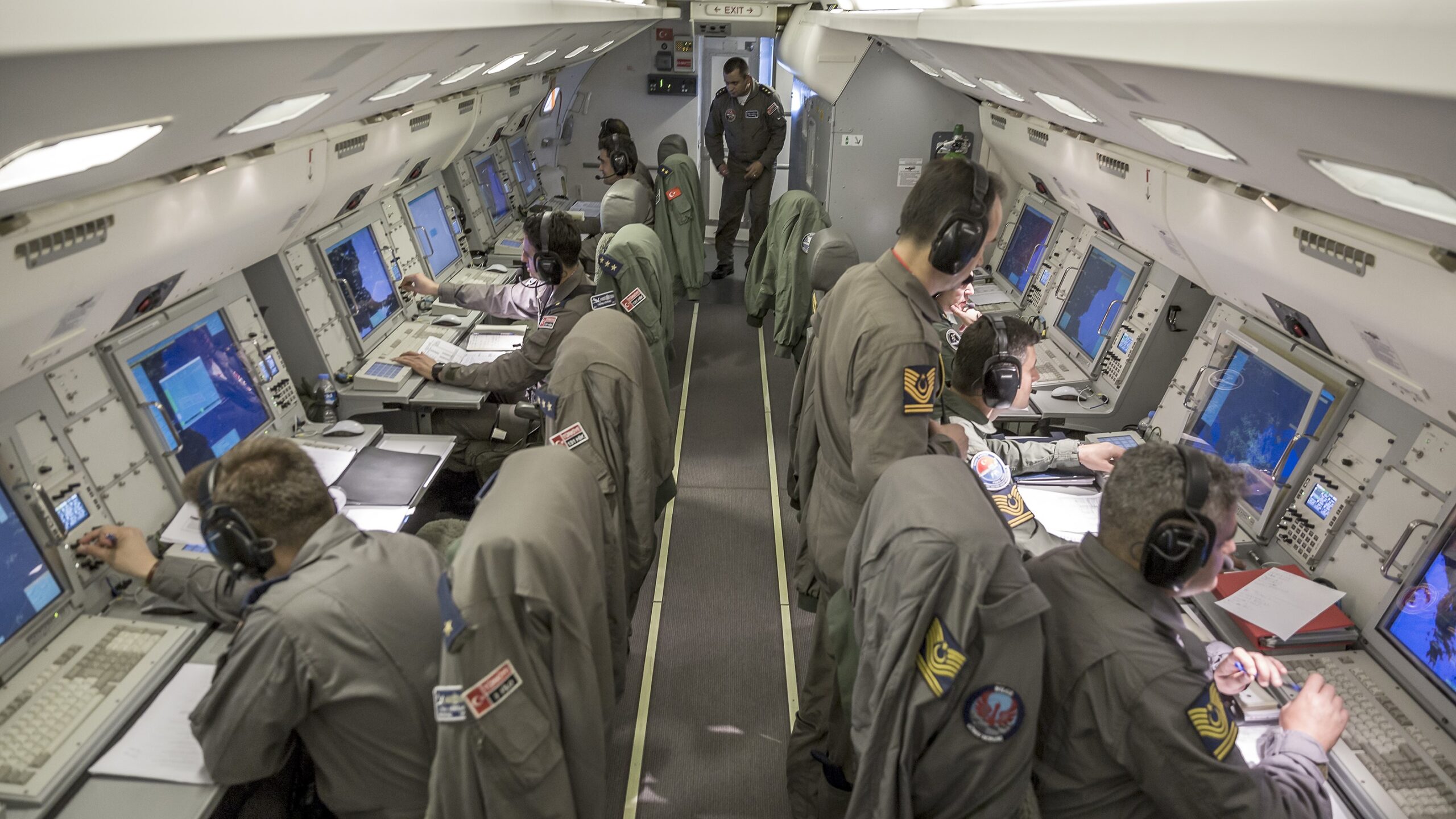
Elmore then pointed to a second screen, tilted at an angle, above the radar scopes.
“The two screens now are being fielded on the Australian’s airplanes, and their upgrade. It was baseline for the U.K. on their platform, and it’s going to be baseline on the U.S. platform. And anybody else after that. Why are two screens important? Well, if you’re looking at a radar picture, seeing all those tracks I was talking about – the scope you saw there – that’s great. But a lot of war is done beyond line of sight as you’re chatting and talking to somebody and all those chat windows pop up, you see a lot of those things.”
The E-7s, he said, “do a lot of coordination back at the Air Operations Center, where the general is and his staff. You don’t want to take up that radar screen by putting your boxes in there. So now you have the opportunity to do that. Leadership can pull over another person’s screen and put it in there.”

Behind the workstations, there’s a crew rest section in the back, said Elmore, “so you can bring more people. You have some nice seats that are pretty cool you can sit in and get some rest. We also have some workstations in the back. We have communication systems in the back. There’s a work table right now but I know there are vendors out there who make smart tables. We can take the mission information, put it on a smart table, you can bring different operators. So you can go anywhere from a 12-person crew to a 21-person crew. The minimum [number of] people to fly this airplane is two pilots and one person to turn on some radios in the back.”
Once again, Meranda chimed in with a question he then answered.
“Why do you need all of those people?” he quipped. “Remember why you want this. Its persistence. You want that capability to always be there and you don’t want to rotate these airplanes very much. We are only buying so many and when you’re in combat AOR [area of responsibility], you want this coverage to all of the area.… And you’re going to rotate another airplane to replace this airplane.”
That means long flights, said Meranda, including some 24-hour missions.

“So you got to get out there and spend eight to 12 hours on station – hit the tanker – same thing that this airplane will be doing too,” he said. “So that’s a long time to be doing a job. So that’s why you have two pilots, one guy or gal will be resting. And same thing for the operators. So you may have all 10 people sitting there actually doing the combat mission. Or you may only have four or five taking rotations. So you want to be a persistent capability out there the entire time.”
Familiar Interfaces
“Similar to our other control scopes that are out there – like on the AWACS right now – this looks very similar to the E-3G human-machine interface,” said Elmore. “And we did that for a reason. We wanted to have a very short training and transition timeframe for the operator when they get out of the E-3 and come to the E-7.”
The E-7 interface is “mouse-operated,” said Elmore. “You’ve got the keyboard, but you right click, drop-down. It’s drop-down menus to set things up. An operator would do a basic setup, ‘how would I like my screen background? Do I want detail? Do I not want detail? What lines do I want on it?’ You would turn those on and off. And then you start hooking tracks, hitting the right mouse, left mouse button, drop-down, do your decision-making, type in parameters as I said for these high-quality tracks…”

Meranda interjected, asking Elmore to explain how the operators “put symbology” on raw radar data that the sensors then gather information off of.
“The machine actually is going to put the track on it,” Elmore said. “Now we got rid of those people, and that track pops up, it starts looking at the algorithm.”
But the process actually starts before the operators even get on the plane, said Elmore.
“It all starts with banking mission planning before you get on the airplane,” he said. “You input a lot of variables and say, ‘if this then that.’ You put that in there. The machine uses those algorithms to take it to a certain position. This is unknown. It came from the other side of the fence if you will. What kind of speed is it doing? Do I have any electronics coming off of [passive detection] it that I can run through my database that says ‘that looks like a radar that’s on a Su-27’ or something like that. And they can recommend to the operator – I recommend based on all of this information and you turn it to – whether it’s a bandit or hostile or whatever the rules of engagement might be for the day.”
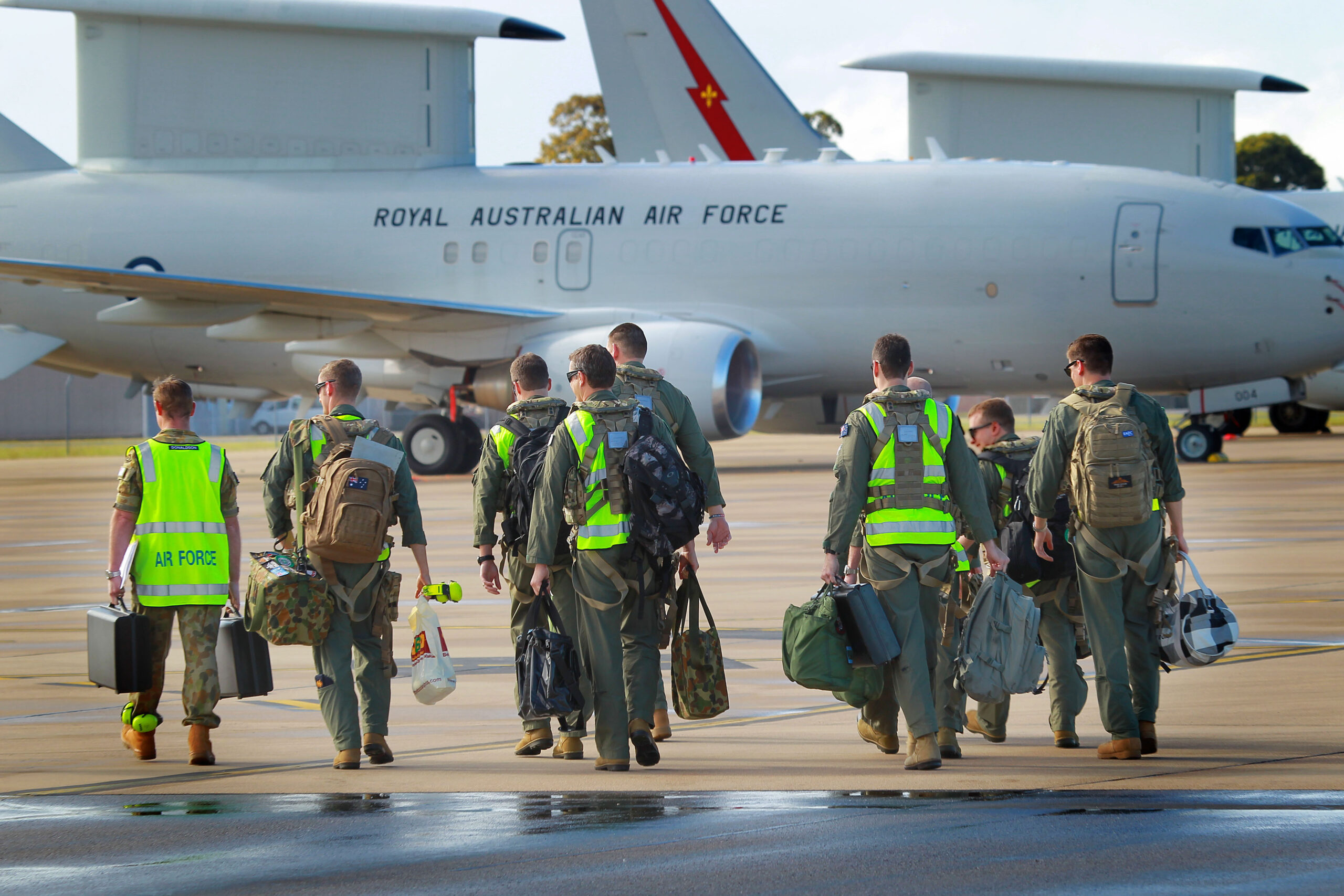
The operator can then “set a box up and say, ‘I’m very focused on what’s happening over here,” said Elmore. “Let’s say you’re flying somewhere on the globe and there’s a left and a right and the right side is the bad guy side. Anything I want off of that – I want a really high-quality track on it. And then they would put a box and say, “anything that pops up, make it high-quality. Give me a track quality of whatever. Then the machine starts doing it for you. Starts managing your radar energy and your radar timeline for you. And you start getting high-quality tracks over there.”
A question about a pencil holder on the consoles elicited a response about humans still playing an important role in the decision-making process.
“People think it’s all machine-to-machine everything and the human does not have to be in the loop,” said Elmore. “Okay, the humans got to be on the loop. And there is always going to be a time where someone’s going to talk to you on the radio and you’re going to have to write something down. You’re not going to be keying it in because the person on the other end has zero respect for your life.”
“We have things called 12 lines, and I’m telling you, there’s a guy 4,000 miles away who could care less what you’re doing, you’re trying to scribble everything down.”
New Situational Awareness Up Front
“Here’s something that’s very different between the AWACS, and the E-7,” said Elmore, pointing to a small screen in the cockpit located to the front of where the pilot’s knee would be.
“The screen you see here in front of you, where all the information is [showing] what’s going on in the battlespace? On an AWACS, they did not have this information up front,” he said.
There was a dedicated crew member in the back called an AWACS monitor, who would relay situational awareness gleaned from the radar scopes in the back to the flight crew in the cockpit, he said.
They would “be in direct communications with the pilots up front saying ‘this is what’s going on. You have an airplane on your left side coming at you 15 miles and he’s 2,000 feet high. You need to look out it’s a tallyho [positively identified within visual range] we’re not going to run into him or something like that.’”

This screen is called the flight deck tactical display, which provides critical mission information to the E-7 flight crew, so “they can see where they are in the battlespace, and they can see what’s around them,” Elmore said. “All of that is integrated into the electronic warfare self-protection.”
“No sir, we’re not going to tell you what it does,” he adds of the electronic warfare self-protection system.
“And mission planning on the ground, they say ‘these are the threats I’m interested in. These are the reactions I want the airplane to take,’ and they do all of that and that’s upfront so now you have two pilots who are taking their destiny into their own hands and participating in the mission with the people in the back.”
Building The Fleet
The other major reason Air Force leaders like Gen. Mark Kelly, head of Air Combat Command, are eager to see the Wedgetail join the fleet is that they are far more reliable than the remaining 31 Sentrys, the first of which entered service in the late 1970s.
Given their age and the lack of available replacement parts for their 707 airframes and TF-33 engines and other components no longer manufactured, the Sentrys have been struggling badly with poor mission-capable rates — the Air Force’s metric that reflects levels of operational readiness. You can read more about that in our previous coverage, here.
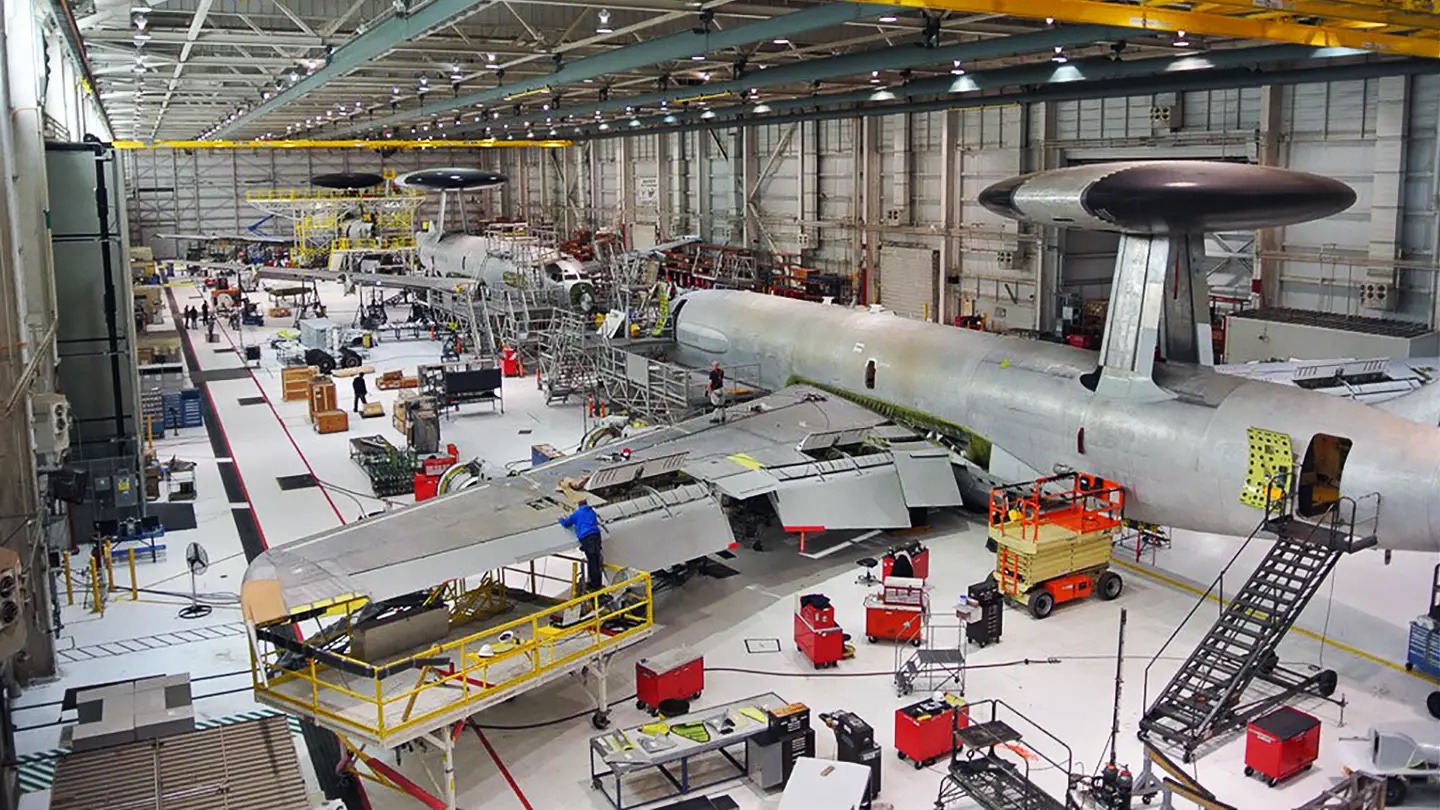
“Like a proud father,” Kelly said last week at the AFA Air Warfare Symposium when asked how he feels about the Air Force finally agreeing to join the U.K., Australia, South Korea and Turkey as Wedgetail operators. “I just wanted more than twins. I want as many those kids as I can as a proud father.“
But getting to more than two Wedgetails is going to take some time, said Meranda.
The Air Force “plans to begin production in fiscal 2025, with the first E-7A expected to be fielded by fiscal 2025 2027,” the flying branch announced in a Feb. 28 press release. “The service anticipates procuring 24 additional E-7As by fiscal 2025 2032. The E-7A total aircraft inventory is projected to be 26.”
“We get asked about going fast,” said Meranda. But it takes “about four years to take a commercial airplane, and make it into an E-7.”
It all starts with a Boeing Next-Generation 737 commercial airplane, of which the company says there are nearly 7,000 across the jet family. It takes about two years to build the airplane, then another two years to modify it into an E-7, add the MESA radar, install 737-800 wings, sturdier landing gear to handle the additional weight, and engineer and add all the other components that make up what the Air Force wants out of the E-7.

Then the Wedgetails have to undergo the requisite testing and certification process.
Assuming that the Air Force opts to go forward with the additional 24 Wedgetails, Elmore said Boeing anticipates being able to build four per year.
So given that the construction process includes two years to build a plane just to tear it apart, why not build it from the ground up?
“First of all, this airplane is not built commercially any longer,” said Meranda. “So the 737 [Next Generation] NG, Increased Gross Weight [IGW], BBJ [Boeing Business Jet] – three different acronyms I just threw at you. It’s a 737-700. It’s not a [737] Max. Boeing Commercial has gone to Maxes. This airplane is still done really, mainly for the military derivatives – for the P-8 [Poseidon], C-40s and also for the E-7. So, to go through a production line, remember, this is not a production line airframe.”
“From the commercial perspective, they build us airplanes, and we take it in-house and go through modifications to it and start chopping this airplane up. The inefficiency of going through a line when you’re trying to produce a number of airplanes? And can you imagine the pause that you would actually have to do to do these kinds of modifications when you’re only talking potentially – we’ve never done four per year – you know, hopefully, that’s where the US Air Force is going to go. That’s not a whole lot. To disrupt that particular chain from the supply, engineers, all of that process would not be beneficial from a cost perspective.”
And there are not a lot of used airframes out there to work with if building is not what the customer wants, Meranda said, even though the U.K. E-7 program is using secondhand airfames.

“Remember, this is not just a straight 737-700. It’s gotta be an Increased Gross Weight – which is different engines. It’s got power packs that are already on those – the nose gear for the weight – all the different structures and stuff like that. There’s not a whole lot of BBJs – Boeing Business Jets. It’s usually that they take that airplane and sell it to other folks who want that type of airframe. So there’s not a lot of those. And especially, this is the short airplane, it’s a 700. It’s not the [800s] or [900s] that Boeing built a lot of.”
Complicating matters, said Elmore, is that Boeing continuously updated its line of 737-700 models.
“So BCA [Boeing Commercial Airplanes] continually makes improvements as they build these airplanes,” he said. “So you got to look at the year of the BBJ that you’ve got. Is that a BBJ1 – if you find that out on the internet. You gotta go find where were the ribbings on this? And where was this? And what did they move? Even if they move something an inch.”
The “sweet spot” for Boeing when it was working with the U.K. “was like a 2010-2011 year model,” said Elmore. “That was engineering we had from the Australians and those are tough to find. ‘Well, I’ve got a 2004, Boeing Business Jet.’ Our engineers have to go back and look, ‘how did Boeing Commercial build it at that time? What’s moved? What’s going to be in the way of where we have wiring that it has to go through? And is it worth the value of deconstructing that airplane?’ We call it ‘green sync.’”

“We have to synchronize it with the engineering we have now and synchronize it with the airplane that’s coming off the line now. Because you’re not going to do a whole fleet of used airplanes, and get those things lined up. Because you only want to build one type of airplane for a customer. So when they go to modify and they cut into the skin, they are not surprised by finding, ‘oh, there’s a ribbing here. We expected to have a place where we’re going to put some pieces of equipment.’”
The long lead time to build the E-7s is not just about the airplane itself, Meranda added.
“Even if we were able to cut off about six months in the airplane, so Northrop [Grumman] – how long does it take to build a sensor? All the other suppliers that have to come in and get in line – so they have their buildup too. And so that takes some time.”
Differences In The Models
There are a number of differences between the E-7s being sought by the U.S. Air Force and those already in service or the procurement process by other nations, said Meranda, but those modifications are being made within the 60-month acquisition process, he said.
“The U.K. right now is taking on three airframes,” he said. “So the airframe is the same, the sensors the same, a lot of the mission equipment is the same. There are some mandates the U.S. Air Force has asked us specifically for. And so this will be the first platform that’ll have an open mission systems software suite. So we owe that to the government. They will test that in [20]25. So that’s different. We’re bringing a lot of other vendors on board for that software with things that you’re going to see.”
“You got to be able to take all of that data that’s coming off that sensor and the other sensors, display it on the console, so the operators can do things, and use all of that. And then be able to update that.”
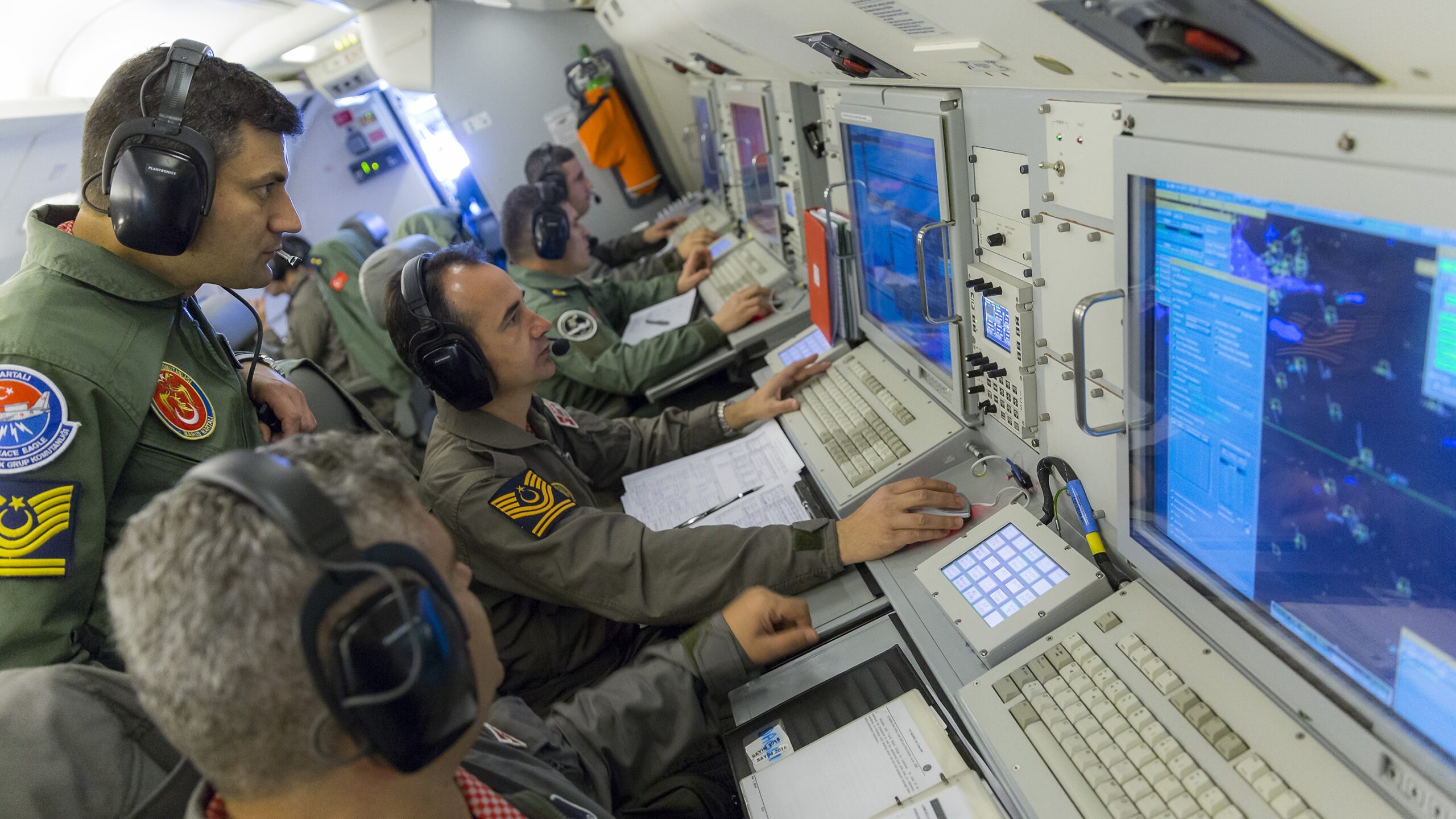
As Meranda noted, one of the key elements of the USAF-specific E-7 will be an Open Mission System architecture or OMS, which allows the rapid insertion of the latest technologies and ease of software updates for them.
“There are four or five other things that the Air Force has asked us specifically that they want,” he said, declining to elaborate.
But the bottom line, said Elmore, is ensuring that “all of these airplanes are interoperable.”
“We take them back through interoperability testing and training,” he said.
There are “agreements between the nations. Key allies and partners want that. They want to be the same as much as possible on equipment and hardware so they can share costs and upgrade at the same time. But they gotta be interoperable so they’ll be able to work and talk to each other when they’re out there in the air. Not only amongst ourselves as a fleet, but with tactical aircraft, ground agencies, and leadership.”
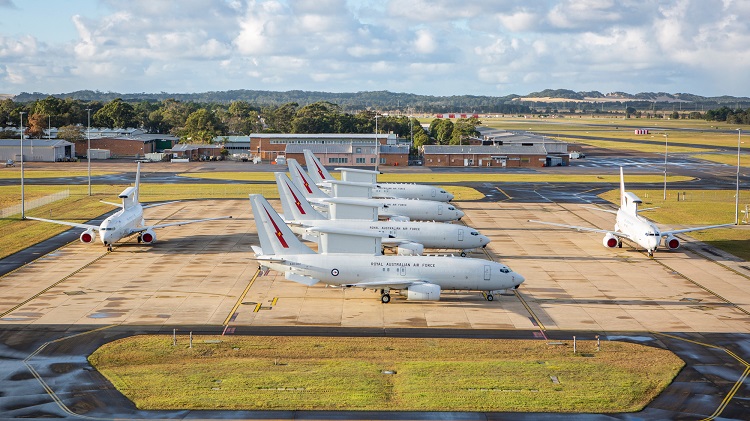
While there is a lot of commonality between the various E-7 models produced and in the works, Elmore could not provide an exact figure on how many common parts they all share.
“But you know, the Australians, the Koreans and the Turks – three fleets across about seven years, 14 airplanes – the commonality is exceptionally high, with the Koreans’ being the last design we had,” he said. “And we took the Australians’ as they made improvements – they had an improvement program called Phase Five A – which underpinned what the U.K. model is going to be which was very close to the Korean [model]. So you got the Australians, the Koreans, the U.K., now the USAF, and the Turks. They participate in a sustainment working group, across all of the customers, and they work on the equipment. The [Decentralized Materiel Support] DMS items. Everybody’s together because it was a small fleet, and you have to have those synergies and those cost savings.”

Simply put, said Meranda, all the customers “are getting the 737. They’re all getting the 737 IGW. They’re getting CFM 56 engines with 90 kVAs [kilovolt amp generators]. You’re getting a Northrop Grumman MESA sensor. You’re getting self-protection capabilities that are going to be whatever your requirements are – it could be international or domestic. Avionics – the flight deck is going to be the same. So all of those kinds of things.”
“The unique things are going to be its mission. What capabilities, really, is the airplane going to do? What do you need the sensor to do? What do you need your self-protection [to do]? What do you need anything else – your software to go do? Indigenous for your requirements of your particular country? That’s what’s the smorgasbord offering. And that goes through the U.S. government to figure out, ‘okay, yes, no, from our perspective, if we can actually license that.’”
Essential Capability
For two decades, the U.S. battled adversaries with no airpower, no seapower and extremely limited air defense capabilities.
That won’t be true in a potential future conflict with China, Russia, Iran or North Korea, making airborne early warning and control an essential capability that the U.S. cannot currently address adequately with its fleet of increasingly decrepit E-3 AWACS.
Still, there are questions as to the E-7’s survivability, especially in a conflict with China, where its ability to standoff safely from enemy air defenses could be in doubt. Space-based capabilities and even penetrating and persistent unmanned aircraft are also being eyed for aspects of the role performed by the E-3, but there still seems to be a clear need for a traditional AEW&C aircraft like the E-7. This is especially true considering its ability to leverage networks that reach far beyond line-of-sight or the reach of its own powerful radar.

Along with aircraft like the EC-37B electronic warfare jets and the Block 4 F-35 Lightning II, the E-7 will help the U.S. dominate the critical electromagnetic spectrum, Kelly, the ACC commander said.
Paraphrasing British World War II Field Marshall Bernard Montgomery, Kelly explained the importance of these aircraft.
“He said – an Army general said – ‘if we lose the war in the air, we’ll lose the war and we’ll lose it quickly,’” Kelly told reporters, including from The War Zone. “And I would offer today this, many years later. If we lose the war in the electromagnetic spectrum, we’re gonna lose the war.”
Contact the author: howard@thewarzone.com
